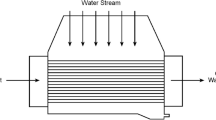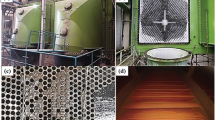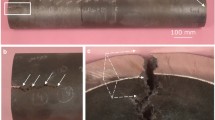Abstract
A detailed failure analysis was conducted on an ammonia refrigerant condenser tube component that failed catastrophically during its initial hours of operation. Evidence collected clearly demonstrated that the weld between a pipe and a dished end contained a sharp unfused region at its root (lack of penetration). Component failure had started from this weld defect. The hydrogen absorbed during welding facilitated crack initiation from this weld defect during storage of the component after welding. Poor weld toughness at the low operating temperature facilitated crack growth during startup, culminating in catastrophic failure as soon as the crack exceeded critical length.
Similar content being viewed by others
References
Metals and Alloys in the Unified Numbering System, 4th ed., Society of Automotive Engineers, 1986, p 127
Metals Handbook, Vol 1,Properties and Selection of Irons and Steels, 9th ed., American Society for Metals, 1983, p 318-319, 320-321,692-693
“Standard Methods for Notched Bar Impact Testing of Metallic Materials,” E 23,Annual Book of ASTM Standards, Part 10, ASTM, 1980, p 197-212
Standard Methods for Mechanical Testing of Welds, ANSI/AWS B 4.0-85, American Welding Society, Florida, 1985, p 31-37
J.F. Lancaster,Metallurgy of Welding, 3rd ed., George Allen & Unwin, London, 1980, p 128–129
Metals Handbook, Vol 1,Properties and Selection of Metals, 8th ed., American Society for Metals, 1961, p 338-340, 343-344
Metals Handbook, Vol 6,Welding, Brazing, and Soldering, 9th ed., American Society for Metals, 1983, p 12
“ASME Boiler and Pressure Vessel Code,” Section VIII, Div. 1, “Requirement for Pressure Vessels Fabricated by Welding,” American Society of Mechanical Engineers, 1992, p 105-108
Metals Handbook, Vol 10,Failure Analysis and Prevention, 8th ed., American Society for Metals, 1975, p 231, 335
Failure Analysis: The British Engine Technical Reports, F.R. Hutching and P.M. Unterweiser, Ed., American Society for Metals, 1981, p 40-41
O.L. Towers, Charpy Requirements for Sub-size Specimens,Weld. Inst. Res. Bull., Vol 19 (No. 8), 1978, p 224–227
O.L. Towers, Testing Sub-size Charpy Specimens: Part I—The Influence of Thickness on the Ductile/Brittle Transition,Met. Constr., Vol 18 (No. 3), 1986, p 171R-176R
H. Udin, E.R. Funk, and J. Wulf,Welding for Engineers, John Wiley & Sons, London, 1954, p 186
C.L. Briant,Metallurgical Aspects of Environmental Failure, Elsevier Science, 1985, p 71-92
Author information
Authors and Affiliations
Rights and permissions
About this article
Cite this article
Muralidharan, N.G., Kaul, R., Kasiviswanathan, K.V. et al. Failure analysis of an ammonia refrigerant condenser tube. JMEP 5, 241–246 (1996). https://doi.org/10.1007/BF02650894
Issue Date:
DOI: https://doi.org/10.1007/BF02650894




